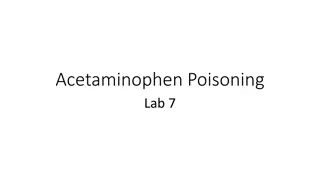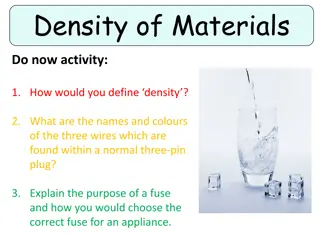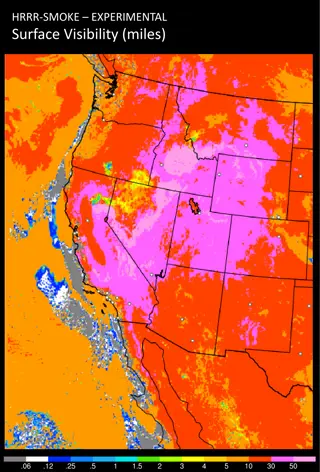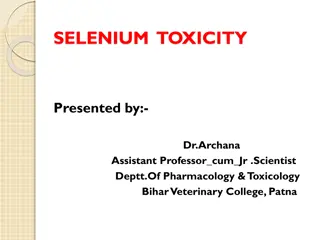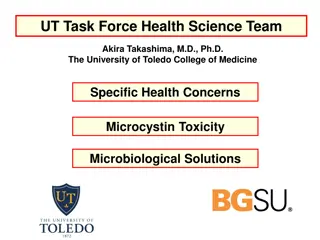Analysis of Smoke Density and Toxicity in Various Transport Modes
This document presents an in-depth analysis of smoke density and toxicity in different transport modes, including maritime, railway, and aircraft. It covers classification documents, testing methods, hazard levels, and measured parameters for evaluating smoke density and toxicity levels. The synthesis includes information on test configurations, test times, irradiation, and maximum individual concentrations of gases. Overall, this analysis aims to provide insights into enhancing safety measures in transportation systems.
Download Presentation

Please find below an Image/Link to download the presentation.
The content on the website is provided AS IS for your information and personal use only. It may not be sold, licensed, or shared on other websites without obtaining consent from the author. Download presentation by click this link. If you encounter any issues during the download, it is possible that the publisher has removed the file from their server.
E N D
Presentation Transcript
Smoke Density and Toxicity Analysis of different classification and test methods used in transport modes C. Vinson - GERFLOR - Strictly Confidential -
SMOKE DENSITY Synthesis MARITIME RAILWAY (EU) RAILWAY (USA) AIRCRAFT (USA/EU) AIRCRAFT EN 45545-1 EN 45545-2 ABD 0031 (Airbus) BSS (Boeing) Classification document IMO / FTP Code 2010 NFPA 130 FAR Part 25 / CS-25 Hazard levels HL1 / HL2 / HL3 ASTM E662 (NBS Smoke chamber) ASTM E662 (NBS Smoke chamber) ASTM E662 (NBS Smoke chamber) FTP Part 2 : EN ISO 5659-2 (NBS Smoke chamber) EN ISO 5659-2 (NBS Smoke chamber) Test method Testing configuration Horizontal Horizontal Vertical Vertical Vertical Test time 20 mn 10 mn 20 mn 20 mn 20 mn 25 kW/m with pilot flame and 25 kW/m without pilot flame and 50 kW/m without pilot flame 25 kW/m with pilot flame or 50 kW/m without pilot flame 25 kW/m with pilot flame and 25 kW/m without pilot flame 25 kW/m with pilot flame and 25 kW/m without pilot flame Irradiation 25 kW/m with pilot flame Dsmax. Measured parameters Dsmax. Ds(4) VOF4 Ds(1,5) Ds(4) Ds(4) Ds(4) (for the 3 types of irradiation) Bulkheads, linings, ceilings 200 Primary deck coverings 400 Floor coverings 500 - Floor composites, Non listed products Dsmax. (25 kW/m ) 600/300/150 - Seat upholstery Dsmax. (25 kW/m ) 300/300/200 - Interior vertical surfaces, Curtains and sunblind Ds(4) (50 kW/m ) 600/300/150 VOF4(50 kW/m ) 1200/600/300 - Flooring wall and ceiling lining and panels 100 - Flooring wall and ceiling lining and panels - Seat upholstery 200 Interior ceiling and wall panels, Partitions, Galley structures 200 Interior ceiling and wall panels, Partitions, Galley structures 200 Level by type of product 2
SMOKE TOXICITY Synthesis RAILWAY (USA) AIRCRAFT (USA/EU) MARITIME RAILWAY (EU) AIRCRAFT Classification document EN 45545-1 EN 45545-2 ABD 0031 (Airbus) BSS (Boeing) IMO / FTP Code 2010 NFPA 130 FAR Part 25 / CS-25 Hazard levels HL1 / HL2 / HL3 AITM 3.0005 (Airbus) BSS 7239 (Boeing) (ASTM E662+ Gases Analysis methods) FTP Part 2 : EN ISO 5659-2 + ISO 19702 (FTIR) EN 45545-2 Annex C (EN ISO 5659-2+FTIR) NF X70-100-1 NF X70-100-2 Test method Testing configuration Horizontal Horizontal Vertical Test time 20 mn 10 mn 20 mn 20 mn 25 kW/m with pilot flame and 25 kW/m without pilot flame and 50 kW/m without pilot flame 25 kW/m with pilot flame 50 kW/m without pilot flame Furnace Temp. : 600 C 25 kW/m with pilot flame and 25 kW/m without pilot flame Irradiation CITNLP CITG at 4 and 8mn (global index for 8 gases, with a comparison between result and reference concentration ) CITGat 4 and 8mn (global index for 8 gases, with a comparison between result and reference concentration ) Measured parameters Maximum individual concentration for 7 gases Maximum individual concentration for 6 gases at 1,5 and 4mn CO 1450 ppm HBr 600 ppm HCl 600 ppm HCN 140 ppm HF 600 ppm / NOx 350 ppm SO2 120 ppm (200 ppm for floor coverings) Floor composites, Seat upholstery Interior vertical surfaces, Curtains and sunblind CITG4 and 8 1,2/0,9/0,75 Interior seals, Non listed products CO 3500 ppm HCl 500 ppm HCN 150 ppm HF 200 ppm NO/NO2 100 ppm SO2 100 ppm Level by type of product CITG 4 and 8 1,2/0,9/0,75 CITNLP 1,2/0,9/0,75 3
SMOKE DENSITY AND TOXICITY Definitions Measured parameters Ds max.: Ds(4): Ds(1.5): VOF4: CITG: CITPNL: Hazard Levels Railway vehicles are classified in accordance with the fire hazard level (HL) dependent on operation and design categories. The three hazard levels are: HL1, HL2 and HL3 with HL1 being the lowest requirement and HL3 being the highest. maximum specific optical density during the total test period product s specific optical density at the time t = 4 mins product s specific optical density at the time t = 1.5 mins modified integral of specific optical density over the first 4 mins global indexs a toxicity for 8 gases, with a comparison between result and reference concentration 4
SMOKE DENSITY AND TOXICITY Conclusion One apparatus with two different testing configuration : horizontal or vertical, Differents irradiations, 25 or 50 kW/m , with or without pilot flame, Two different test time :10 or 20 minutes, For DENSITY differents measured parameters : Ds at time, Ds max, VOF with different time : 1,5 20 minutes, For TOXICITY 2 differents approach : maximum concentration for each gas or global index All these parameters have a significant influence on the result. As it is difficult to determine an ideal configuration, I think it is better to work first on the spread of fire. 5


